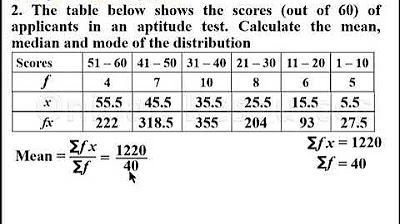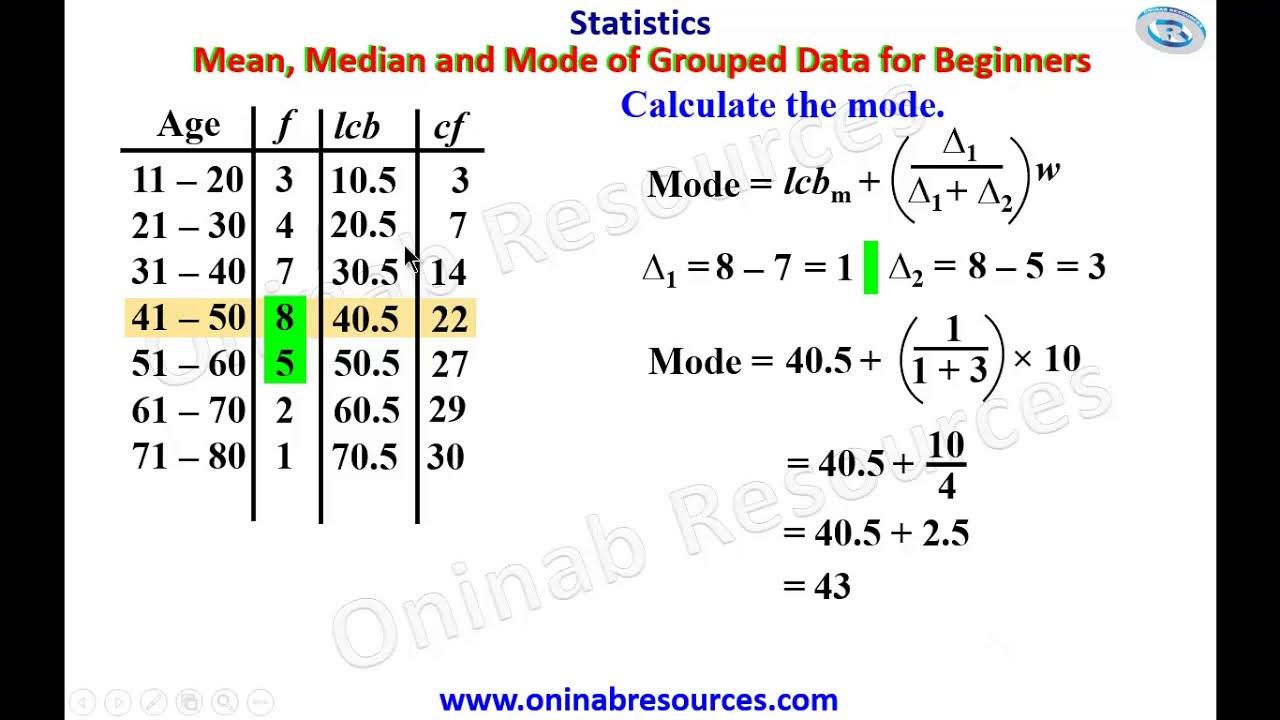Mean, median and mode of grouped Data(Lesson 1)
TLDRIn this instructional video, the presenter guides viewers through the process of calculating the mean, median, and mode for grouped data, using a table of weights from a sports club as an example. The video explains how to reorganize data into a vertical form, calculate the mid-value of class intervals, and determine the FX column. It then demonstrates the formulas for mean, median, and mode, including how to identify the median class and calculate the lower class boundary. The presenter concludes with the final values for mean, median, and mode, providing a clear and concise tutorial on statistical analysis of grouped data.
Takeaways
- 📊 The video script is a tutorial on calculating the mean, median, and mode for grouped data.
- 📈 The example used is the weight distribution of members in a sports club, presented in a table.
- 🔄 The table is reorganized from a horizontal to a vertical form to facilitate the calculations.
- 📝 The formula for calculating the mean involves summing the product of frequency (f) and mid-value (x) of each class interval, then dividing by the total frequency.
- 🧮 The mean weight is calculated to be 67.9 kg using the formula and the reorganized data.
- 🔢 To find the median, the formula involves identifying the median class, which is the class containing the middle values in an ordered dataset.
- 🏋️♂️ The median class is determined to be 60-69 kg, and the lower boundary of this class is calculated to be 59.5 kg.
- 📊 The median is calculated using the lower boundary of the median class, cumulative frequencies, and the frequency of the median class, resulting in a median weight of 68.67 kg.
- 🔑 The mode is found by identifying the class with the highest frequency, which is considered the modal class.
- 📉 The mode is calculated using the lower boundary of the modal class, differences in frequencies of adjacent classes, and the class size, yielding a mode of 71.72 kg.
- 📚 The video concludes with instructions to subscribe to the channel for more educational content.
Q & A
What statistical measures are discussed in the video?
-The video discusses how to calculate the mean, median, and mode of grouped data.
What is the first step in calculating the mean for grouped data?
-The first step is to reorganize the data from a horizontal form to a vertical form and create a column for the mid-value (x) of each class interval.
How is the mid-value (x) of a class interval calculated?
-The mid-value (x) is calculated by finding the average of the upper and lower limits of each class interval.
What does the term 'FX' represent in the context of calculating the mean?
-FX represents the product of frequency (f) and the mid-value (x) of the class interval.
How is the mean of the distribution calculated from grouped data?
-The mean is calculated by summing up all the FX values and then dividing by the total number of observations.
What formula is used to find the median in grouped data?
-The median is found using the formula Lm + ((Σf/2) - Cf) / f, where Lm is the lower class boundary of the median class, Σf is the sum of frequencies, and Cf is the cumulative frequency of the class before the median class.
How do you determine the median class in a set of grouped data?
-The median class is determined by identifying the class that contains the middle value(s) of the dataset, which in this case is the class containing the 25th and 26th members.
What is the purpose of calculating the cumulative frequency?
-The cumulative frequency is used to determine the total number of observations up to a certain class, which is necessary for finding the median and mode.
How is the mode of a distribution calculated from grouped data?
-The mode is calculated using the formula Lm + (Δ1/(Δ1 + Δ2)) * C, where Lm is the lower class boundary of the modal class, Δ1 and Δ2 are the differences in frequencies between the modal class and adjacent classes, and C is the class width.
What is the significance of the class width in calculating the mode?
-The class width (C) is used to adjust the lower class boundary of the modal class to find the exact mode value.
How does the video conclude?
-The video concludes with the final calculated values for the mean, median, and mode of the given data set and a reminder to subscribe to the channel.
Outlines
📊 Calculating Mean, Median, and Mode for Grouped Data
This paragraph introduces the process of calculating the mean, median, and mode for grouped data using an example of a sports club's members' weights. The speaker explains the need to reorganize the data from a horizontal to a vertical form, calculate the mid-value (X) for each class interval, and then determine the frequency times the mid-value (FX). The mean is calculated by summing FX and dividing by the total frequency. The median is found by identifying the median class, calculating the lower class boundary, and applying the median formula. Detailed steps include finding the cumulative frequency, lower class boundary, and frequency of the median class to derive the median value.
🔢 Detailed Steps for Median Calculation in Grouped Data
The second paragraph delves deeper into calculating the median for grouped data. It explains how to determine the median class by locating the middle members of the dataset and how to find the lower class boundary of the median class. The speaker provides the formula for the median and guides through the process of calculating the cumulative frequency, the frequency of the median class, and the class size. The formula is then applied with these values to find the median, which represents the middle value of the dataset.
📈 Determining the Mode of Grouped Data
The final paragraph focuses on calculating the mode of the grouped data. It begins by identifying the modal class as the one with the highest frequency. The speaker outlines the steps to find the lower class boundary of the modal class, calculate the differences between the frequencies of adjacent classes (Delta 1 and Delta 2), and determine the class size. These values are then used in the mode formula to calculate the mode, which is the value that appears most frequently in the dataset. The paragraph concludes with the final mode calculation and a reminder to subscribe to the channel.
Mindmap
Keywords
💡Statistics
💡Ungrouped Data
💡Grouped Data
💡Mean
💡Median
💡Mode
💡Class Interval
💡Frequency
💡Mid-value
💡Cumulative Frequency
Highlights
Introduction to calculating mean, median, and mode of grouped data.
Reorganizing a horizontal table into a vertical form for easier calculations.
Explanation of the formula for calculating the mean using summation of FX over summation of f.
Creation of a new column for x, representing the mid-value of class intervals.
Calculation of the mid-value by averaging the upper and lower limits of each class interval.
Determination of FX as the product of frequency and the mid-value of the class interval.
Summation of frequencies to ensure the total equals the number of members in the dataset.
Calculation of the mean using the total FX sum divided by the total number of frequencies.
Introduction to the formula for calculating the median in grouped data.
Identification of the median class based on the total number of members.
Explanation of how to find the lower class boundary of the median class.
Calculation of cumulative frequency to determine the position of the median.
Determination of the median using the class width and cumulative frequencies.
Introduction to the formula for calculating the mode in grouped data.
Identification of the modal class as the class with the highest frequency.
Explanation of how to calculate the lower class boundary of the modal class.
Calculation of the differences between frequencies to find Delta 1 and Delta 2.
Determination of the class size or width for the modal class.
Final calculation of the mode using the provided formula and class parameters.
Conclusion summarizing the mean, median, and mode of the grouped data distribution.
Transcripts
Browse More Related Video

Statistics of Grouped Data: Mean, Median and Mode

Measures of Central Tendency (Grouped Data) | Basic Statistics

Mean, Median and Mode of Grouped Data(Lesson 2)

Measure of Central Tendency of Grouped Data for beginners

Statistics - Mean, Median & Mode for a grouped frequency data

FORM 2 MATHS STATISTICS I MEAN,MODE & MEDIAN
5.0 / 5 (0 votes)
Thanks for rating: